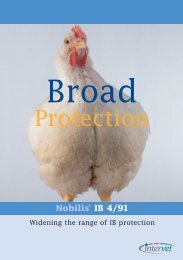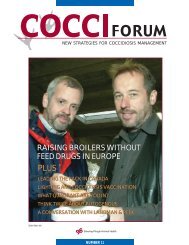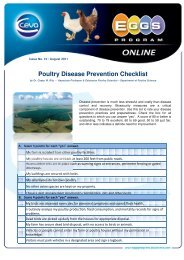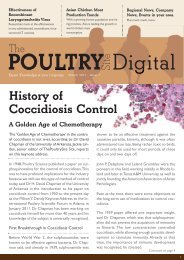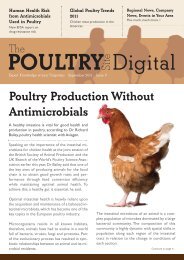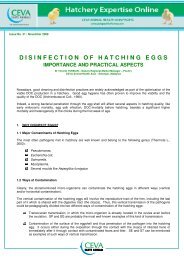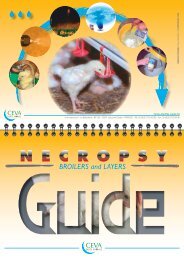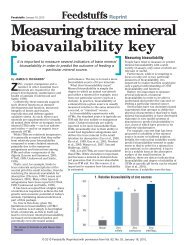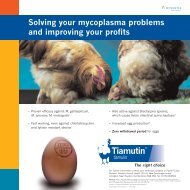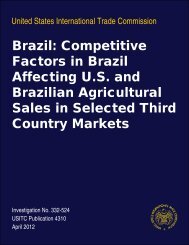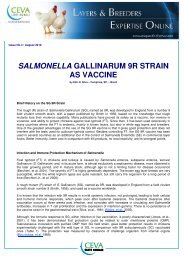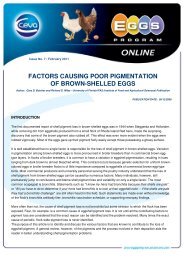July - Monitoring IBD Vaccination From Hatchery - The Poultry Site
July - Monitoring IBD Vaccination From Hatchery - The Poultry Site
July - Monitoring IBD Vaccination From Hatchery - The Poultry Site
You also want an ePaper? Increase the reach of your titles
YUMPU automatically turns print PDFs into web optimized ePapers that Google loves.
Issue No.31 / <strong>July</strong> 2010<br />
MONITORING <strong>IBD</strong> VACCINATION<br />
FROM HATCHERY TO FARM<br />
by Dr Vincent TURBLIN – Deputy Regional Market Manager, <strong>Poultry</strong><br />
Ceva Animal Health Asia Pacific – Malaysia<br />
INTRODUCTION<br />
Any good vaccine needs a proper administration to provide its full benefits. That’s why CEVA has always been<br />
at the spearhead of hatchery vaccination in the world, and much more than only in manufacturing vaccines, has<br />
found out new technologies to administer them in a convenient and trustable way.<br />
Moreover, the utilization of these machines and these vaccines needs to be checked regularly, implying a<br />
reliable control in the hatcheries. Any industrial production has its own Quality Control, and CEVA package is<br />
now providing the tool for this QC follow up of vaccination in hatcheries thanks to C.H.I.C.K. Program. This is a<br />
real tool for preventing vaccination failure and improving the vaccination technique itself.<br />
Part of this program is indeed to explain in detail the monitoring to be done with specific SOP (Standard<br />
Operating Procedures): you will find hereafter some key points of its implementation in hatcheries, and then,<br />
how we can monitor further in the farms with the new available laboratory tools, the vaccine take of live vaccines<br />
like CEVAC® TRANSMUNE <strong>IBD</strong>.<br />
<strong>Vaccination</strong> Control <strong>The</strong>ory<br />
Control of the Volume Injected: Dosing Accuracy<br />
Volume control is systematically performed at the beginning of each<br />
vaccination day and repeated each time the number of vaccinated chicks<br />
does not match the number of vaccine doses used (e.g., 800 or 1,200<br />
chicks for a 1,000 doses bag/bottle). It consists in measuring the volume<br />
obtained after 50 injections in a graduated cylinder. <strong>The</strong> amount found<br />
must be 5ml with a syringe adjusted for 0.1ml dose, and 10ml with a<br />
syringe adjusted at 0.2ml. This volume may appear quite high but is<br />
necessary to reach a good evaluation assessment.<br />
One should bear in mind that semi-automatic machines are set to deliver 5% extra dose and that a vaccine<br />
bottle generally contains 5% more vaccine than the volume indicated in the label (safety margins). <strong>The</strong><br />
mechanical construction tolerances of these machines (0.1 mm) result in practice in a dose variation ranging<br />
between 0% and 10%. <strong>The</strong>refore, it is considered normal to vaccinate between 900 and 1,100 chicks with a<br />
1,000 dose bag/bottle and between 4,500 and 5,500 chicks with a 5,000 dose bag/bottle.
2<br />
Control of Injection <strong>Site</strong>: Injection Quality Efficiency<br />
Accuracy of the injection site depends on the machine settings, which must be corrected if required. Also, when<br />
the work pace is too fast in semi-automatic or manual vaccination, it is not rare that the operator maintains the<br />
chick in an inadequate position and injection is not performed properly. <strong>The</strong> operator’s level of fatigue is often<br />
involved.<br />
Injection Quality Efficiency (%)<br />
Birds effectively injected / Total of Vaccinated Birds<br />
Badly vaccinated chicks are:<br />
1. Wet fluff <strong>The</strong> dose is not fully injected inside the bird<br />
2. Bloody /Injured Chicks Bleeding on the neck caused by the injection<br />
3. Wrong position Injection in the bad place.<br />
4. Killed chicks Chicks killed by the injection.<br />
5. Non vaccinated Without vaccine trace<br />
An oil-based vaccine (white) can be readily discerned under the skin. On the contrary, a water-based vaccine<br />
like CEVAC ® TRANSMUNE <strong>IBD</strong> will require the use of a specific dye (e.g. Patent Blue V).<br />
Pic. 1 : Correct subcutaneous injection<br />
of a colored water-based vaccine.<br />
Pic. 2 : "Wet fluff": Injection in dawn<br />
or insufficient insertion of the needle<br />
under the skin. <strong>The</strong> vaccine flows out<br />
from the puncture site.<br />
Pic. 3 : Injury due to incorrect<br />
machine setting or inadequate<br />
positioning of the chick during<br />
subcutaneous injection in the neck.<br />
<strong>Monitoring</strong> of the Number of <strong>Vaccination</strong>s and the <strong>Vaccination</strong> Speed Rate<br />
It is essential to fill in a vaccination record that includes all the useful elements for reliable traceability of the<br />
operations:<br />
Date and time<br />
Machine number<br />
State of the machine at the beginning of vaccination<br />
Operator’s name<br />
Vaccine name and presentation (number of doses)<br />
Expiry date and batch number of the vaccine/diluent<br />
Number of vaccinated chicks and volume injected per bird<br />
Number of chicks with “wet dawn”, bleeding, lameness or killed<br />
Remarks<br />
CEVA ANIMAL HEALTH ASIA PACIFIC<br />
3.06 Level 3, Wisma Academy – 4A, Jln 19/1 – 46300 P.Jaya – Selangor – Malaysia – Tel: +603 7957 4440 – Fax: +603 7954 4702
3<br />
For the evaluation of the <strong>Vaccination</strong> Speed, it should be considered the number displayed in the counter at the<br />
Start Time of the evaluation and the same for the end. <strong>The</strong> best is to consider an average speed in different<br />
moments (3 rounds) per operator and then by the vaccination crew.<br />
Equipment<br />
Standard Range of Birds Vaccinated / Hour<br />
AUTOVAC 2,500 to 3,000<br />
DOVAC SINGLE 2,500 to 3,000<br />
DOVAC DOUBLE 2,000 to 2,500<br />
<strong>Monitoring</strong> in the Field<br />
In general, with conventional <strong>IBD</strong> vaccination through drinking water, serology is not very easy to interprete.<br />
<strong>The</strong>re are indeed big variations, related to the initial level of MDA of the day-old chicks, the overall immune<br />
status of the chicks and the time needed to seroconvert, the possible confusion with field pressure<br />
seroconversion, and the live vaccine strain used.<br />
Combined with a good traceability of the hatchery injection, a farm monitoring of the vaccine take is however<br />
very important for <strong>IBD</strong> vaccination since subclinical forms are very frequent and cause big economical losses.<br />
Only the new biomolecular tools can provide us a clear picture of the situation in the monitored farms, by a<br />
direct demonstration of the presence of <strong>IBD</strong>V and its precise identification.<br />
Practically in the farms, the replication of the <strong>IBD</strong> vaccine<br />
strain in the bursa will obviously occur BEFORE the onset<br />
of the serological response. <strong>The</strong>refore, the samples can<br />
be taken earlier than blood samples, in general between<br />
20 and 30 days of age. <strong>The</strong> bursas are sampled<br />
individually and placed in clean vials or plastic bags, to be<br />
sent frozen to a laboratory able to proceed the<br />
Polymerase Chain Reaction and, then, the sequencing or<br />
RFLP (Restriction Fragment Length Polymorphism)<br />
identification on the amplified Nucleic Acid. In case of<br />
sequencing, the homology with the Genbank and<br />
laboratory database can state if it is either the vaccine<br />
strain (successful vaccination) or a wild strain (classical<br />
vv<strong>IBD</strong>, or variant).<br />
<strong>The</strong> phylogenic analysis by sequencing performed on the<br />
408 base pairs long (721-1128 bp) nucleotide sequence<br />
of the hypervariable region of the vp2 gene of <strong>IBD</strong>V will<br />
then give the kind of following results, appreciating the<br />
distances between each strain.<br />
Another interest of this new kind of farm monitoring is linked to the following works of Palya and co-workers<br />
(personal communication). <strong>The</strong>y indeed evaluated the time needed for the development of protection against<br />
vv<strong>IBD</strong>V infection after the vaccine take. Demonstration was done that as soon as 2 days post-replication of<br />
W2512, no other <strong>IBD</strong> virus could replicate in the bursa: the place was taken, and the door closed for field virus<br />
infection. This mechanism of action could explain the excellent protection of live immune-complex vaccines<br />
against early challenge by wild <strong>IBD</strong> viruses, even with low titers between the 3rd to 4th weeks of age as it can<br />
be noticed sometimes before the complete seroconversion.<br />
CEVA ANIMAL HEALTH ASIA PACIFIC<br />
3.06 Level 3, Wisma Academy – 4A, Jln 19/1 – 46300 P.Jaya – Selangor – Malaysia – Tel: +603 7957 4440 – Fax: +603 7954 4702
4<br />
Transportation of the Bursa of Fabricius<br />
For transportation of the bursa samples, the FTA cards<br />
are much easier to handle and safer since the paper is<br />
purposely soaked with disinfectant to denature viruses<br />
but can preserve the nucleic acids (RNA or DNA).<br />
Nevertheless, some critical points related in our specific<br />
SOP for its usage have to be respected in order not to<br />
contaminate it and get a reliable analysis.<br />
CONCLUSION<br />
In practice, vaccination control in hatcheries involves performing On-site technical assistance by training and<br />
audits programs for hatchery managers and operators. In this context, the C.H.I.C.K. Program, can provide<br />
some Audits and Diagnostic Forms for monitoring all factors related to the injection vaccination process from the<br />
preparation and handling of vaccines, including the equipment operability and the vaccination process itself.<br />
<strong>The</strong>se materials were developed to support the practices of hatchery vaccination in order to reach an optimal<br />
standard on <strong>Vaccination</strong> Quality and to keep records.<br />
Besides, the monitoring of <strong>IBD</strong> vaccination can be extended to farm level thanks to biomolecular techniques,<br />
providing a complete information about both the vaccination quality and the field pressure occurring in some<br />
particular areas. Both surveys are complementary and are aiming at the best control of <strong>IBD</strong> in the field and<br />
hence to the best economical performance of the flocks.<br />
CEVA ANIMAL HEALTH ASIA PACIFIC<br />
3.06 Level 3, Wisma Academy – 4A, Jln 19/1 – 46300 P.Jaya – Selangor – Malaysia – Tel: +603 7957 4440 – Fax: +603 7954 4702



